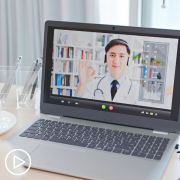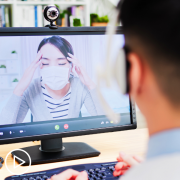How Is Treatment for Head and Neck Cancer Evolving?
How Is Treatment for Head and Neck Cancer Evolving? from Patient Empowerment Network on Vimeo.
How is head and neck cancer treatment evolving over time? Watch as expert Dr. Samantha Tam from Henry Ford Health System explains current areas of research focus in head and neck cancer – and how researchers are working toward the best care for patients.
See More From The Head & Neck Cancer TelemEDucation Empowerment Resource Center
Related Resources:
Transcript:
Samantha Tam, MD, FRCSC, MPH:
So, treatment of head and neck cancer is constantly evolving with the introduction of immuno-therapeutic agents, understanding the role of that in the treatment of head and neck cancer is currently undergoing a lot of research. And there’s a lot of interest in curiosity about how we can utilize that in conjunction with the more traditional treatments of head and neck cancer. Another major focus in head and neck cancer now is to ensure that we’re not overtreating our patients, especially those with HPV-positive disease, and so understanding the balance between treatment care of the disease as well as maximizing function and quality of life after treatment of the disease has become a major focus in head and neck cancer and is certainly at the forefront of our minds.
Do Telephone-Only Visits Qualify As a Telemedicine Visit?
Do Telephone-Only Visits Qualify As a Telemedicine Visit? from Patient Empowerment Network on Vimeo.
For head and neck cancer patients, do telephone-only visits really qualify as a telemedicine visit? Watch as expert Dr. Samantha Tam from Henry Ford Health System explains care concerns that can be covered in telephone versus video visits – and patients who can benefit from the use of virtual visits.
See More From The Head & Neck Cancer TelemEDucation Empowerment Resource Center
Related Resources:

|
Transcript:
Samantha Tam, MD, FRCSC, MPH:
So from a… Telephone-only visits have a lot of drawbacks to them, I think even virtually assessing a patient with regards to how they’re doing generally, a general physical examination is very important. On top of that, we have a lot of sensitive conversations in patients that have head and neck cancer, so it’s important to also read things like non-verbal body language, so definitely the video component is extremely useful for providers that are caring for patients with head and neck cancer. However, in patients that might not have access to video visits, might not have the technology, I think that the number one priority in our minds is that this patient gets the best care that they are able to get, and whether that this means a telephone-only type of a visit is possible for these patients, we adjust our…I guess we adjust our requirements, we adjust our ability to deliver care based on that, so that might mean touching base with the patient on the phone at first in order to understand exactly what they’re going through, talk them through the next steps so that they know what to accept in order to make their care more streamlined later on. I don’t think that telephone visits will completely replace either virtual visits or in-person visits, but I think that, again, they are a tool, and they’re a tool that especially patients that might be more disadvantaged, such as not having access to good Internet might not have access to the technology required for a virtual visit, those patients need to be considered when we consider utilizing telephone-only care.
Is Telemedicine a Mainstay for Head and Neck Cancer Patients?
Is Telemedicine a Mainstay for Head and Neck Cancer Patients? from Patient Empowerment Network on Vimeo.
Will head and neck cancer care continue with telemedicine in the future? Watch as expert Dr. Samantha Tam from Henry Ford Health System shares her perspective on her expectations for the use of telemedicine versus in-person visits with head and neck cancer patients.
See More From The Head & Neck Cancer TelemEDucation Empowerment Resource Center
Related Resources:
Transcript:
Samantha Tam, MD, FRCSC, MPH:
So while COVID-19 has forced us into utilizing telemedicine in context that we might not nearly have used them in the past, I think that telemedicine is here to stay, though perhaps not as wide spreading universal as it has been at the beginning of the pandemic. Telemedicine to me, seems to be a very good adjunct to our in-person visits, I think seeing patients and evaluating them in-person is essential in head and neck cancer throughout the treatment course. That being said, I think that telemedicine really adds a value into patient’s care, there are several ways that we have used this at Henry Ford in order to enhance access to our services, one is with patient intake, when we have some information, we can certainly start to…we can meet with you, get a good clinical history and understand exactly what is going on, and therefore expedite investigations that are required, and then condense our visits to just one in-person visit versus multiple in-person visits. Another way that I have used this is checking in with patients while they’re in the middle of treatment, sometimes patients are getting daily radiation, not close to my office, but I like to check on them to make sure from a symptom standpoint that they’re tolerating their treatment well.
And certainly coming down for a visit would be impossible, so checking in with them virtually has been a good way to monitor treatment side effects and to ensure everything is going smoothly from that standpoint. With surveillance, there have been also options that way to check in with patients that are more on the survivorship end of things to see how things are going that way though, I often do like to see patients in follow up in-person just so that we can also complete an endoscopic examination as clinically indicated.
What Head and Neck Cancer Treatment Side Effects Can Be Monitored via Telemedicine?
What Head and Neck Cancer Treatment Side Effects Can Be Monitored via Telemedicine? from Patient Empowerment Network on Vimeo.
For head and neck cancer patients, which treatment side effects are acceptable to be monitored via telemedicine? Watch as expert Dr. Samantha Tam from Henry Ford Health System explains vital aspects for monitoring treatment side effects, key symptoms for patients to report, and some patient monitoring methods that are helpful in care.
See More From The Head & Neck Cancer TelemEDucation Empowerment Resource Center
Related Resources:
Transcript:
Samantha Tam, MD, FRCSC, MPH:
One of the most important aspects in terms of treatment side effects is understanding what the patient feels with regards to their symptoms and reporting this to the physician. Something that we’re using at Henry Ford currently is remote patient-reported outcomes measurement, which looks at several domains of symptomology that we are monitoring throughout your treatment. These questionnaires can be completed online remotely at home, and don’t necessarily need an in-patient visit. This is a platform that can be utilized to communicate with providers in order to understand what the treatment side effects might be, and also a standardized way to discuss with your physician exactly what kind of side effects you might have from treatment.
So I think it’s important to be a self-advocate for your care, and so certainly as a provider, I’m happy to hear any kind of concerns that you have about side effects from treatment, pain, bleeding. I think one of the big ones is whether or not you’re doing well with swallowing and how your weight has been. Energy level is another major indicator about how much you’re able to take in and how well you’re tolerating the treatment. All these types of components are important things for us to know throughout your treatment course, and I think speaking up about any kind of concerning symptoms you have is important for your provider to know so that we understand exactly what’s going on.
Tips for a Telemedicine Visit From a Head and Neck Cancer Expert
Tips for a Telemedicine Visit From a Head and Neck Cancer Expert from Patient Empowerment Network on Vimeo.
How can head and neck cancer patients prepare for telemedicine visits? Watch as expert Dr. Samantha Tam from Henry Ford Health System shares her tips for telemedicine best practices and tests that can be helpful used in conjunction with virtual care.
See More From The Head & Neck Cancer TelemEDucation Empowerment Resource Center
Related Resources:

|
Transcript:
Samantha Tam, MD, FRCSC, MPH:
So in head and neck cancer, a lot of the virtual visits are mainly based on obtaining a clinical history and having a discussion with your provider verbally as opposed to a lot of physical examination, this is unfortunately the limit of virtual care, and definitely, especially in head and neck cancer, a lot of our examination is through into your ears, into your nose, into your mouth with endoscopic examinations weaved into it, and definitely like CT scans are useful as a modality, as a modality of investigation to have ready prior to your visit with your head and neck cancer provider. Tips that I have for families and for patients that are facing a diagnosis of head and neck cancer before your virtual visit is to make sure that you have any kind of questions that you have written down so that you can make sure that your provider is able to go through each one of these questions to ensure that you have a good understanding of exactly what the next steps are, or what the diagnosis is and what the plan might be moving forward.
How Has Telemedicine Impacted Head and Neck Cancer Clinical Trials?
How Has Telemedicine Impacted Head and Neck Cancer Clinical Trials? from Patient Empowerment Network on Vimeo.
How have head and neck cancer clinical trials been impacted by telemedicine? Watch as expert Dr. Samantha Tam from Henry Ford Health System provides her perspective on scenarios when telemedicine can improve clinical trial access and how care disparities can be changed through the use of telemedicine access.
See More From The Head & Neck Cancer TelemEDucation Empowerment Resource Center
Related Resources:

|
Transcript:
Samantha Tam, MD, FRCSC, MPH:
While I don’t have specific data on how clinical trial participation has been impacted through telemedicine, I believe that the impact would be several ways, one is that patients that might not be able to access in-person care at a certain center may be introduced to an interesting clinical trial and therefore seek care at a specific center based on that clinical trial, but also there may be patients that might not be able to access the clinical trial because they have not been able to access in-person care at those centers. My current research is not so much in the clinical trials realm, but more exploratory currently, and looking at how we can empower communities that may be at an disadvantage to access telemedicine and virtual care, especially in these times when all institutions have been moving more towards using technology in their delivery of care, so as to ensure that patients are not left behind just because of their potential disadvantages.
When Should Head and Neck Cancer Patients Seek In-Person Care?
When Should Head and Neck Cancer Patients Seek In-Person Care? from Patient Empowerment Network on Vimeo.
What are instances for head and neck cancer patients to seek in-person visits for care? Watch as expert Dr. Samantha Tam from Henry Ford Health System explains situations that warrant in-person visits to care providers and her recommended precautions to ensure optimal safety for in-person care.
See More From The Head & Neck Cancer TelemEDucation Empowerment Resource Center
Related Resources:

|
Transcript:
Samantha Tam, MD, FRCSC, MPH:
So to protect yourself from the Delta variant of coronavirus, one of the most important steps would be for vaccination and also following national guidelines in terms of how to protect yourself generally, like good hand hygiene, mask wearing, et cetera, et cetera, in terms of trying to seek care virtually versus in-person, patients should discuss this with their provider to see exactly what they are comfortable with, some post-operative visits might be able to be moved to a virtual platform, but again, sometimes it is difficult to examine patients with…that have undergone complex head and neck cancer surgery on a virtual platform adequately. So I think that a one-on-one discussion with your provider should give you a good idea about what can be moved in-person onto a virtual platform, and that way you can ensure that you have the adequate amount of care that you need for your head and neck cancer.
Okay. Seeking in-person care, I think is especially important for patients that are having symptoms from their head and neck cancer, these patients are the ones that I would consider at highest risk for some type of abnormality on physical examination that we might not be able to catch on a virtual platform, and patients that are far out from surveillance and well into survivorship, these visits might be less necessary to be in person. So again, I think it’s important for you to discuss with your provider regarding whether or not they think that you need to be seen in person versus virtually.
Disparities in Telemedicine Access for Head and Neck Cancer Patients
Disparities in Telemedicine Access for Head and Neck Cancer Patients from Patient Empowerment Network on Vimeo.
Which head and neck cancer patients have experienced disparities in telemedicine access? Watch as expert Dr. Samantha Tam from Henry Ford Health System explains patient demographics with less access to care and how these disparities can be reduced.
See More From The Head & Neck Cancer TelemEDucation Empowerment Resource Center
Related Resources:

|
Transcript:
Samantha Tam, MD, FRCSC, MPH:
So, during the pandemic, there was a large uptake of virtual care that was pretty unprecedented previously, and a lot of the times patients didn’t have any other options aside from accessing care through telemedicine because of the precautions that were taken within institutions in limiting in-person care. With this, we saw that there was a very specific demographic that we’re able to access telemedicine, and there were some patients that potentially could have been left behind. These patients are usually patients that have lower SES (socioeconomic status) indicators such as lower median household income, or perhaps lack of insurance coverage and the difficulty, especially in head and neck cancer, is that a lot of the times, these are the same patients that are at highest risk for head and neck cancers or have the highest needs in head and cancer. And certainly understanding who these patients are is extremely important, so that we ensure that we have equitable delivery of health care to these patients, and we don’t utilize these platforms that put these patients that are already at a disadvantage at more of a disadvantage.
Head and Neck Cancer, What Are Telemedicine Challenges and Opportunities?
Head and Neck Cancer, What Are Telemedicine Challenges and Opportunities? from Patient Empowerment Network on Vimeo.
For head and neck cancer patients, what barriers and opportunities have emerged from the addition of telemedicine? Watch as expert Dr. Samantha Tam from Henry Ford Health System shares insight about obstacles that she has seen for some patients and some helpful ways these challenges have been overcome in patient care.
See More From The Head & Neck Cancer TelemEDucation Empowerment Resource Center
Related Resources:

|

|
Transcript:
Samantha Tam, MD, FRCSC, MPH:
So there are lots of challenges and opportunities for virtual care and patients with head and neck cancer. One of the challenges is the fact that a lot of head and neck cancers occur within the upper air or digestive tract and therefore it’s very difficult to examine patients or to get an idea of the extent of their cancer, or the disabilities, or difficulties patients encounter as a result of their cancer, because of where the cancer is. On top of that, a lot of patients present to us with difficulties with communication, either they have hoarseness because of glottic cancer or maybe they have airway distress and they already have a tight tube resulting in their inability to formulate well, especially over virtual platforms such as the telephone or virtually through the Internet. These are the major challenges though, they can be overcome with things such as typing answers through the chat functions, as well as writing on a tablet in order for us to read. However, there have been a lot of opportunities for patients with head and neck cancers, I think that the major opportunities are with patients that are seeking help from allied health professionals such as speech language pathologists, psychologists, dietitians, social workers, a lot of these providers that are very involved in the care of patients throughout diagnosis, treatment as well as surveillance.
These visits are sometimes not requiring any physical examination, not requiring any endoscopic examination and may be well completed through a virtual platform such as telemedicine.
How Has the Pandemic Reshaped Head and Neck Cancer Care?
How Has the Pandemic Reshaped Head and Neck Cancer Care? from Patient Empowerment Network on Vimeo.
How has head and neck cancer care changed from the COVID-19 pandemic? Watch as expert Dr. Samantha Tam from Henry Ford Health System shares situations for in-person vs. telemedicine visits.
See More From The Head & Neck Cancer TelemEDucation Empowerment Resource Center
Related Resources:

|

|

|
Transcript:
Samantha Tam, MD, FRCSC, MPH:
COVID-19 has significantly changed how healthcare is delivered to patients with head and neck cancer. Traditionally head and neck cancer care has been delivered in-person visits because patients with head and neck cancers are often difficult to examine on a virtual platform, and on top of that, many patients have difficulties with communication, just given the ramifications of the disease. However, with COVID-19, we had a conscious effort to shift a lot of our care from in-person to virtual visits, and the area of telemedicine has been therefore greatly expanded in patients with head and neck cancer diagnosis. How head and neck cancer patients have been able to utilize telemedicine has been varied according to whether or not these patients are coming in for new diagnoses for follow-up care, for post-op diagnoses or for care during their treatment. And I feel that virtual care is really complementary as opposed to a substitute for patients with head and neck cancer because certainly there are innate difficulties in communication through the virtual platforms, as well as innate difficulties with examining patients adequately through the virtual platform.
That being said, there’s a lot of care, for example, with allied health professionals, or surveillance care that can be completed on a virtual platform that may use healthcare delivery to patients that may not be able to access in-person care on a regular basis
Extended Quick Guide to Medicare
This guide was originally published by our partner, Triage Cancer, here.
2021-Health-Insurance-Medicare-Quick-GuideQuick Guide to Health Insurance Options
This guide was originally published by our partner, Triage Cancer, here.
2021-Health-Insurance-Options-Quick-Guide



